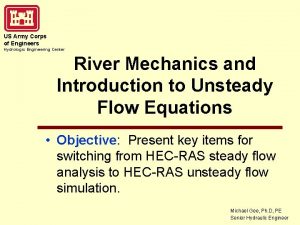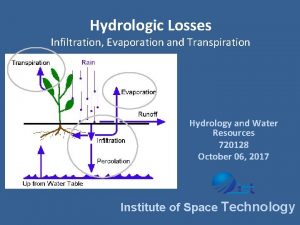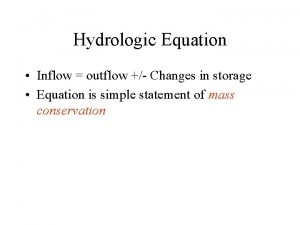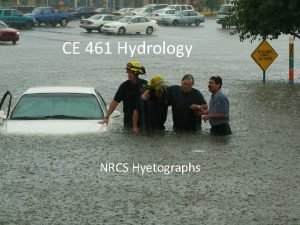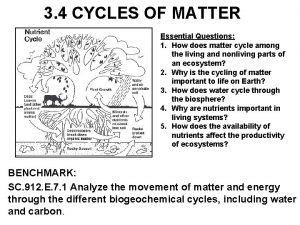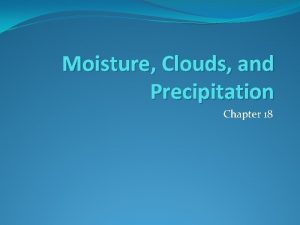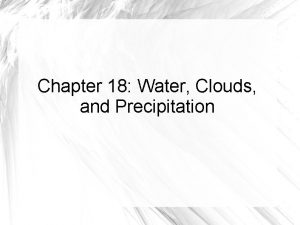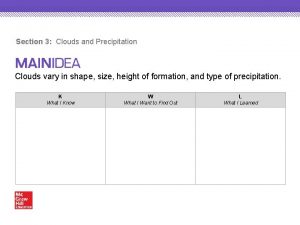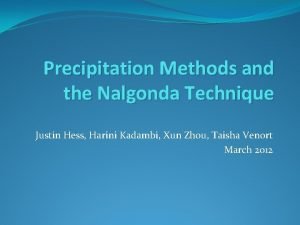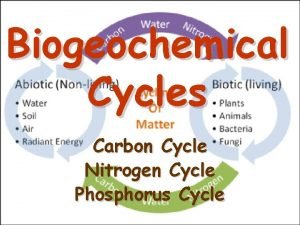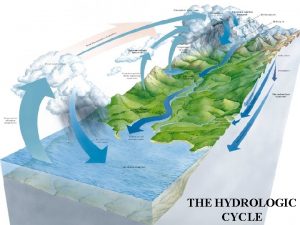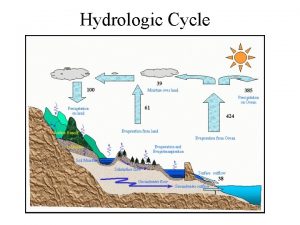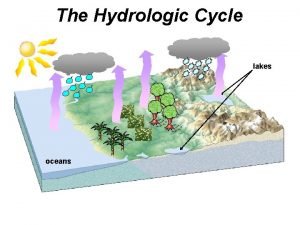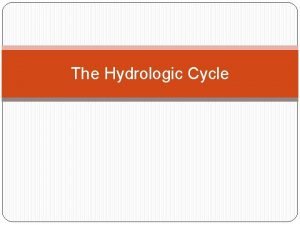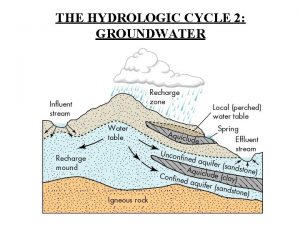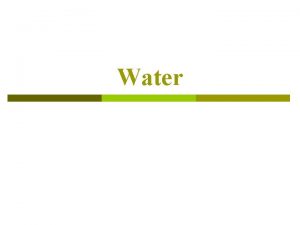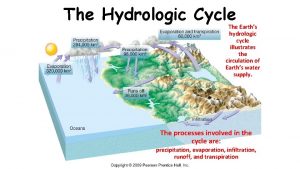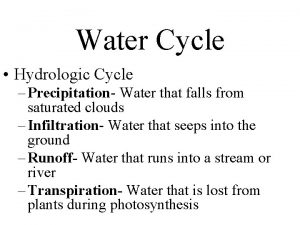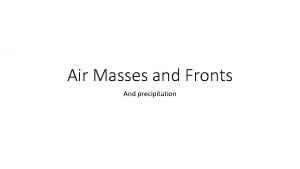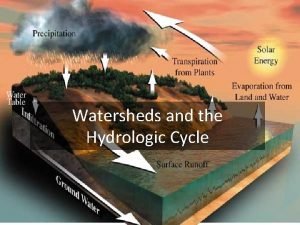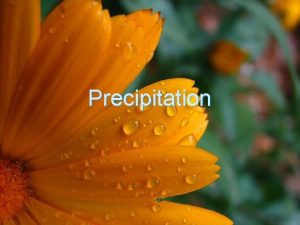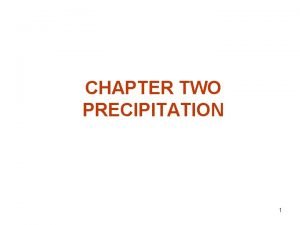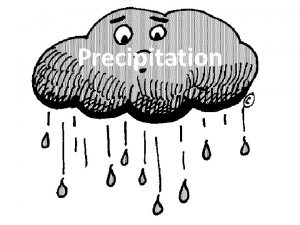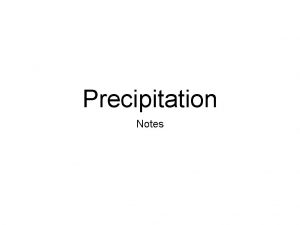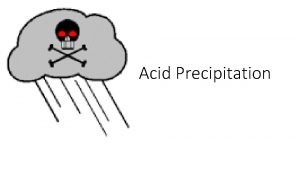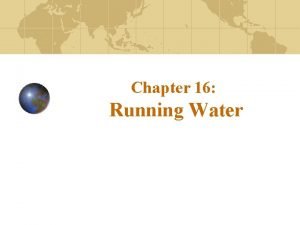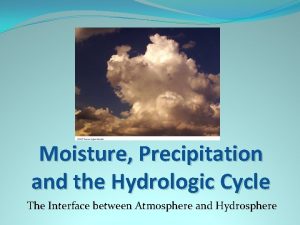Hydrologic Cycle and Precipitation Lecture Goals 1 Understand










































- Slides: 42

Hydrologic Cycle and Precipitation

Lecture Goals 1. Understand the major components of the hydrologic cycle. 2. Appreciate the wide variety of precipitation types in various climate regions and lay a foundation for how precipitation affects upcoming topics such as runoff and erosion. 3. Quantitatively use important concepts such as return period and storm duration. 4. Discuss precipitation data availability Key Words: hydrology cycle, precipitation, water balance

What are the components of the hydrologic cycle?

Hydrologic Cycle

Hydrologic Measurements • Want data to help understand weather patterns, help predict future weather, design conservation structures, reduce NPS pollution, etc. • Precipitation – rain gage and/or snow gage • Accumulated snow – snow survey • Runoff – stream gages • Evaporation – pan, ET w/ lysimeters, sap flow meters • Groundwater levels – monitoring wells • Other important meteorological data for modeling and design: • Wind speed • Solar radiation • Temperature

Hydrologic Data • National Oceanic and Atmospheric Administration (NOAA) • Climate/Weather data • http: //www. noaa. gov/ • http: //hdsc. nws. noaa. gov/hdsc/pfds/ • http: //www. ncdc. noaa. gov/ • United States Geological Survey (USGS) • Water Quantity • http: //www. usgs. gov/ • United States Environmental Protection Agency (USEPA) • Water Quality • http: //www 3. epa. gov/ • United States Department of Agriculture (USDA) • Soils • http: //websoilsurvey. sc. egov. usda. gov/App/Home. Page. htm

Hydrologic Data Analysis • Statistics – the science of collecting, summarizing, organizing, analyzing, exploring and interpreting data. • Plot data • Descriptive Statistics • Statistics of location/central tendency • Statistics of dispersion and variability • Experimental Error • Standard Error • Confidence Intervals • Probabilities and Distributions

The Drainage Basin as a Flow System (From Jones 1997) Runoff = Inputs – Outputs Storage

Water Balance Inputs – Outputs = Change in Storage Precipitation Runoff Subsurface Flow Irrigation Storage Evaporation Transpiration Runoff • Water Budget Volumes Infiltration Deep Seepage • • Ft 3 (m 3) Gal (L) Acre-feet (ac-ft) Inches (cm) over an area

Example How much irrigation is required during the growing season if the crop requires 850 mm of water for optimal production? How many liters of water will be pumped if the field is 10 ha? Precipitation = 500 mm Percolation below root zone 50 mm Runoff = 15 mm

Solution Inputs – Outputs = Change in Storage Inputs = precipitation (500 mm) + irrigation (? ) Outputs = runoff (15 mm) and deep seepage (50 mm) Change in storage = Water required by plants (850 mm) (500 + I) – (15 + 50) = 850 Irrigation = 415 mm Liters of water = 415 mm * 10 ha = 0. 415 m * 100, 000 m 2 = 41500 m 3 = 41, 500, 000 L

Precipitation

What is precipitation?

Precipitation • Precipitation: water falling from the atmosphere to the earth. • The primary input into the hydrologic cycle. • Atmospheric moisture condenses and forms: • Rain, snow, hail, drizzle, sleet, fog and dew. • Most precipitation falls as rain. • Rain has the largest impact on erosion. • Requires lifting of air mass so that it cools and condenses.

How does precipitation form?

Mechanisms for air lifting

Condensation • Condensation is the change of water vapor into a liquid. For condensation to occur, the air must be at or near saturation in the presence of condensation nuclei. • Condensation nuclei are small particles or aerosol upon which water vapor attaches to initiate condensation. Dust particulates, sea salt, sulfur and nitrogen oxide aerosols serve as common condensation nuclei. • Size of aerosols range from 10 -3 to 10 mm.

Precipitation formation • Lifting cools air masses so moisture condenses • Condensation nuclei (Aerosols) that water molecules attach to • Rising & growing • 0. 5 cm/s sufficient to carry 10 mm droplet • Critical size (~0. 1 mm) • Gravity overcomes and drop falls

Rain • Raindrops can be as large as 7 mm in diameter. • Uniform droplets less than 0. 5 mm in diameter is drizzle. • The speed of fall depends on the size of the raindrop. • Terminal velocity, Vterm=3. 86 D 0. 67 • Larger raindrops have more energy. • Higher intensity storms typically have larger raindrops. • Intensity = depth of precipitation / time


Precipitation Variation • Influenced by • Atmospheric circulation and local factors • Higher near coastlines • Seasonal variation – annual oscillations in some places • Variables in mountainous areas • Increases in plains areas • More uniform in Eastern US than in West

Global Rainfall





How is precipitation measured?

Precipitation Measurement

Cumulative Rainfall Mass Curve

Arithmetic Mean Method • Simplest method for determining areal average P 1 = 10 mm P 1 P 2 = 20 mm P 3 = 30 mm P 2 P 3 • Gages must be uniformly distributed • Gage measurements should not vary greatly about the mean

Thiessen polygon method • • • Any point in the watershed receives the same amount of rainfall as that at the nearest gage Rainfall recorded at a gage can be applied to any point at a distance halfway to the next station in any direction Steps in Thiessen polygon method 1. Draw lines joining adjacent gages 2. Draw perpendicular bisectors to the lines created in step 1 3. Extend the lines created in step 2 in both directions to form representative areas for gages 4. Compute representative area for each gage 5. Compute the areal average using the following formula P 1 A 1 P 2 A 2 P 3 A 3 P 1 = 10 mm, A 1 = 12 Km 2 P 2 = 20 mm, A 2 = 15 Km 2 P 3 = 30 mm, A 3 = 20 km 2


Isohyetal method • Steps • Construct isohyets (rainfall contours) • Compute area between each pair of adjacent isohyets (Ai) • Compute average precipitation for each pair of adjacent isohyets (pi) • Compute areal average using the following formula 10 20 P 1 A 1=5 , p 1 = 5 A 2=18 , p 2 = 15 P 2 A 3=12 , p 3 = 25 30 P 3 A 4=12 , p 3 = 35

NEXRAD • NEXt generation RADar: is a doppler radar used for obtaining weather information • A signal is emitted from the radar which returns after striking a rainfall drop • Returned signals from the radar are analyzed to compute the rainfall intensity and integrated over time to get the precipitation NEXRAD Tower http: //radar. weather. gov/radar. php? rid=twx&produ ct=N 0 R&overlay=11101111&loop=no

Precipitation Data Analysis • Intensity (mm/hr) • Duration (time) • Frequency (time)

Hydrologic Frequency Analysis • Many statistical methods have been used for precipitation analysis. • Connect discrete precipitation event analyses to design storm prediction. • Used for predicting storms of specific frequency and duration for a given location.

Hydrologic Frequency Analysis T = 100/P Where T = return period in years, P = probability in percent that an observed event in a given year is equal to or greater than a given event.

Return Period • The return period (reoccurrence interval) is the period within which the depth of precipitation for a specified duration will be equaled or exceeded once on the average • Example: • The 100 yr-24 hr precipitation depth for Manhattan, KS is 7. 5 inches. • Thus, Manhattan receives 7. 5 inches of precipitation within a 24 hr period on average once every 100 years over many 100 year periods.

'1, 000 -year' flood: Weather hyperbole or hard science? • http: //www. cnn. com/videos/weather/2015/10/04/south-carolina-flood-govnikki-haley-sot. wis

Example What is the probability that an event with a 10 year return period will occur in any given year? P = 100/T = 100/10 = 10% The probability of occurrence for a precipitation event is 40%. How often do expect this event? T = 100/P = 100/40 = 2. 5 years


United States Resources • www. weather. gov • http: //hdsc. nws. noaa. gov/hdsc/pfds/ • http: //www. ncdc. noaa. gov/ • https: //www. ksre. ksu. edu/wdl/
 Water cycle the hydrologic cycle
Water cycle the hydrologic cycle Steps of gravimetric analysis
Steps of gravimetric analysis Co precipitation and post precipitation
Co precipitation and post precipitation Strategic goals tactical goals operational goals
Strategic goals tactical goals operational goals Strategic goals tactical goals operational goals
Strategic goals tactical goals operational goals To understand recursion you must understand recursion
To understand recursion you must understand recursion Hydrologic continuity equation
Hydrologic continuity equation Hydrologic engineering center
Hydrologic engineering center Reservoir flood routing worked examples
Reservoir flood routing worked examples Hydrologic routing
Hydrologic routing Infiltration
Infiltration Hydrologic equation
Hydrologic equation Hydrologic abstractions
Hydrologic abstractions Objectiveable
Objectiveable Continuity equation hydrology
Continuity equation hydrology Hydrologic engineering center
Hydrologic engineering center Hydrograph
Hydrograph River analysis system
River analysis system Hydrologic engineering center
Hydrologic engineering center General goals and specific goals
General goals and specific goals Motivation in consumer behaviour
Motivation in consumer behaviour 01:640:244 lecture notes - lecture 15: plat, idah, farad
01:640:244 lecture notes - lecture 15: plat, idah, farad Matter cycle
Matter cycle A picture of precipitation
A picture of precipitation Cumulus clouds
Cumulus clouds 3clouds
3clouds Methods of defluoridation of water ppt
Methods of defluoridation of water ppt Moisture clouds and precipitation
Moisture clouds and precipitation Significance of biogeochemical cycle
Significance of biogeochemical cycle Difference between phosphorus cycle and carbon cycle
Difference between phosphorus cycle and carbon cycle Difference between open cycle and closed cycle gas turbine
Difference between open cycle and closed cycle gas turbine Forbidden latency
Forbidden latency Chapter 5 principles of engine operation
Chapter 5 principles of engine operation Difference between open cycle and closed cycle mhd system
Difference between open cycle and closed cycle mhd system It helps us understand people and societies.
It helps us understand people and societies. Understand quran and salah the easy way
Understand quran and salah the easy way Understand quran and salah the easy way
Understand quran and salah the easy way Qualitative quantitative
Qualitative quantitative Bc bce ad ce
Bc bce ad ce Understand quran and salah the easy way
Understand quran and salah the easy way Understand quran and salah
Understand quran and salah Understandquran
Understandquran Www.understand quran and salah
Www.understand quran and salah







